Yonina C Eldar
Channel Estimation with Hybrid Reconfigurable Intelligent Metasurfaces
Jun 08, 2022

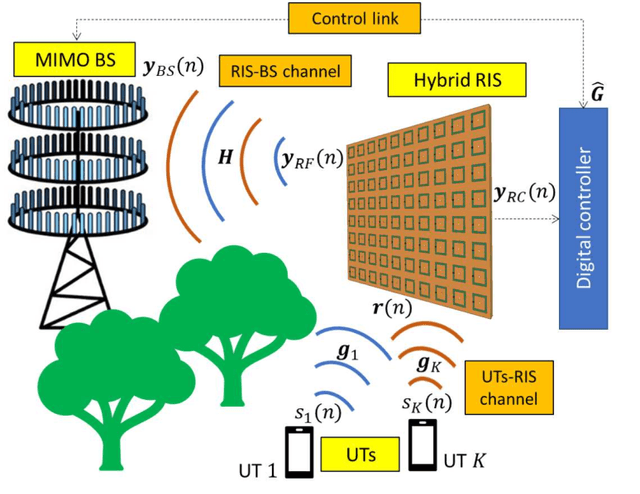
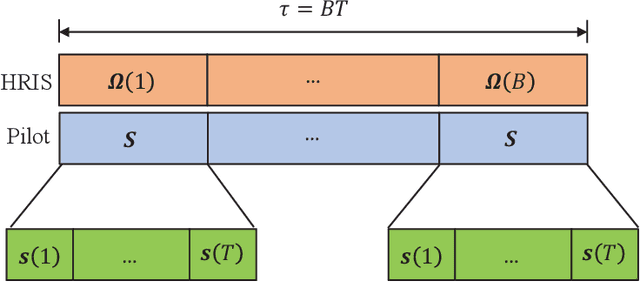
Abstract:Reconfigurable Intelligent Surfaces (RISs) are envisioned to play a key role in future wireless communications, enabling programmable radio propagation environments. They are usually considered as almost passive planar structures that operate as adjustable reflectors, giving rise to a multitude of implementation challenges, including the inherent difficulty in estimating the underlying wireless channels. In this paper, we focus on the recently conceived concept of Hybrid Reconfigurable Intelligent Surfaces (HRISs), which do not solely reflect the impinging waveform in a controllable fashion, but are also capable of sensing and processing an adjustable portion of it. We first present implementation details for this metasurface architecture and propose a convenient mathematical model for characterizing its dual operation. As an indicative application of HRISs in wireless communications, we formulate the individual channel estimation problem for the uplink of a multi-user HRIS-empowered communication system. Considering first a noise-free setting, we theoretically quantify the advantage of HRISs in notably reducing the amount of pilots needed for channel estimation, as compared to the case of purely reflective RISs. We then present closed-form expressions for the MSE performance in estimating the individual channels at the HRISs and the base station for the noisy model. Based on these derivations, we propose an automatic differentiation-based first-order optimization approach to efficiently determine the HRIS phase and power splitting configurations for minimizing the weighted sum-MSE performance. Our numerical evaluations demonstrate that HRISs do not only enable the estimation of the individual channels in HRIS-empowered communication systems, but also improve the ability to recover the cascaded channel, as compared to existing methods using passive and reflective RISs.
Near-Field Wireless Power Transfer with Dynamic Metasurface Antennas
Oct 10, 2021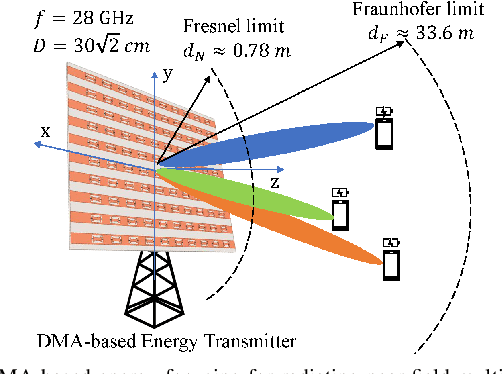
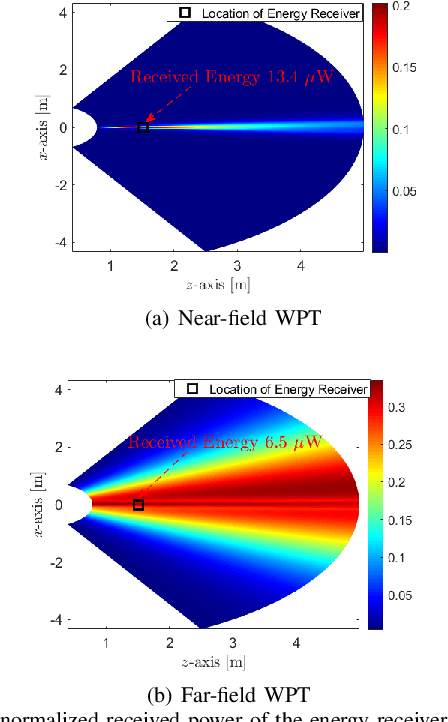

Abstract:Radio frequency wireless power transfer (WPT) enables charging low-power mobile devices without relying on wired infrastructure. Current existing WPT systems are typically designed assuming far-field propagation, where the radiated energy is steered in given angles, resulting in limited efficiency and possible radiation in undesired locations. When large arrays at high frequencies, such as DMA, are employed, WPT might take place in the radiating near-field (Fresnel) region where spherical wave propagation holds, rather than plane wave propagation as in the far-field. In this paper, we study WPT systems charging multiple devices in the Fresnel region, where the energy transmitter is equipped with an emerging DMA, exploring how the antenna configuration can exploit the spherical wavefront to generate focused energy beams. In particular, after presenting a mathematical model for DMA-based radiating near-field WPT systems, we characterize the weighted sum-harvested energy maximization problem of the considered system, and we propose an efficient solution to jointly design the DMA weights and digital precoding vector. Simulation results show that our design generates focused energy beams that are capable of improving energy transfer efficiency in the radiating near-field with minimal energy pollution.
Deep Learning for Ultrasound Beamforming
Sep 23, 2021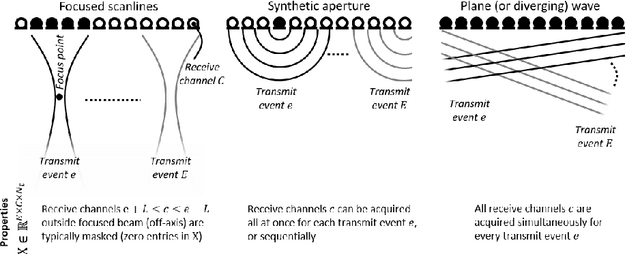
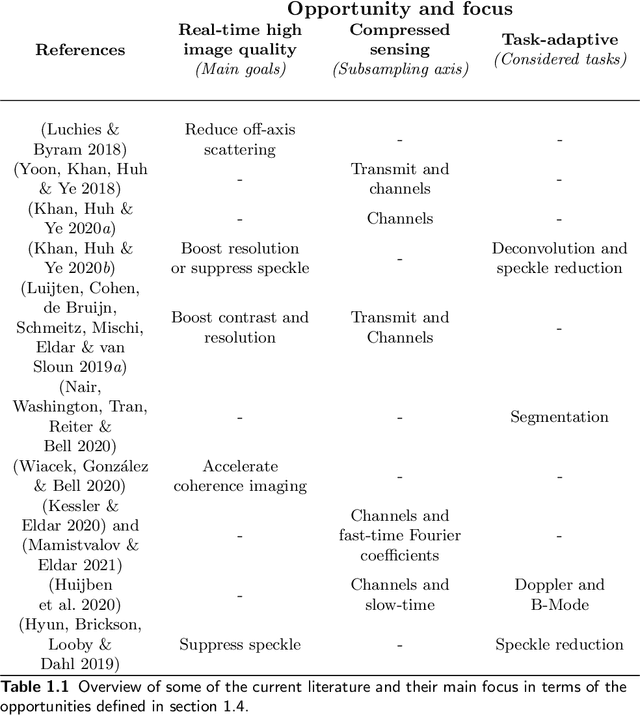
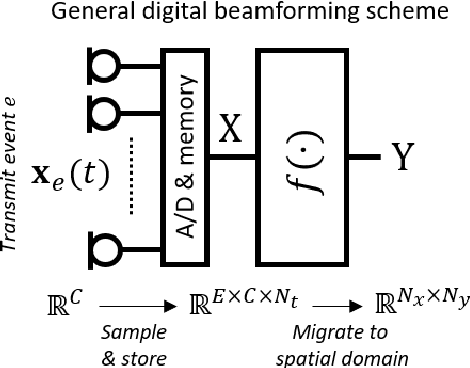
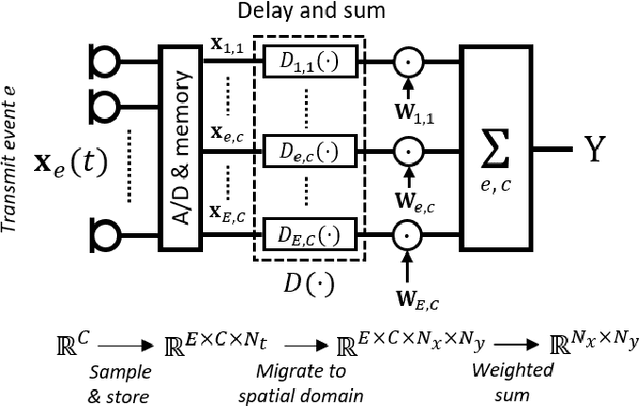
Abstract:Diagnostic imaging plays a critical role in healthcare, serving as a fundamental asset for timely diagnosis, disease staging and management as well as for treatment choice, planning, guidance, and follow-up. Among the diagnostic imaging options, ultrasound imaging is uniquely positioned, being a highly cost-effective modality that offers the clinician an unmatched and invaluable level of interaction, enabled by its real-time nature. Ultrasound probes are becoming increasingly compact and portable, with the market demand for low-cost pocket-sized and (in-body) miniaturized devices expanding. At the same time, there is a strong trend towards 3D imaging and the use of high-frame-rate imaging schemes; both accompanied by dramatically increasing data rates that pose a heavy burden on the probe-system communication and subsequent image reconstruction algorithms. With the demand for high-quality image reconstruction and signal extraction from less (e.g unfocused or parallel) transmissions that facilitate fast imaging, and a push towards compact probes, modern ultrasound imaging leans heavily on innovations in powerful digital receive channel processing. Beamforming, the process of mapping received ultrasound echoes to the spatial image domain, naturally lies at the heart of the ultrasound image formation chain. In this chapter on Deep Learning for Ultrasound Beamforming, we discuss why and when deep learning methods can play a compelling role in the digital beamforming pipeline, and then show how these data-driven systems can be leveraged for improved ultrasound image reconstruction.
COVID-19 Classification of X-ray Images Using Deep Neural Networks
Oct 07, 2020Abstract:In the midst of the coronavirus disease 2019 (COVID-19) outbreak, chest X-ray (CXR) imaging is playing an important role in the diagnosis and monitoring of patients with COVID-19. Machine learning solutions have been shown to be useful for X-ray analysis and classification in a range of medical contexts. The purpose of this study is to create and evaluate a machine learning model for diagnosis of COVID-19, and to provide a tool for searching for similar patients according to their X-ray scans. In this retrospective study, a classifier was built using a pre-trained deep learning model (ReNet50) and enhanced by data augmentation and lung segmentation to detect COVID-19 in frontal CXR images collected between January 2018 and July 2020 in four hospitals in Israel. A nearest-neighbors algorithm was implemented based on the network results that identifies the images most similar to a given image. The model was evaluated using accuracy, sensitivity, area under the curve (AUC) of receiver operating characteristic (ROC) curve and of the precision-recall (P-R) curve. The dataset sourced for this study includes 2362 CXRs, balanced for positive and negative COVID-19, from 1384 patients (63 +/- 18 years, 552 men). Our model achieved 89.7% (314/350) accuracy and 87.1% (156/179) sensitivity in classification of COVID-19 on a test dataset comprising 15% (350 of 2326) of the original data, with AUC of ROC 0.95 and AUC of the P-R curve 0.94. For each image we retrieve images with the most similar DNN-based image embeddings; these can be used to compare with previous cases.
Deep learning in ultrasound imaging
Jul 29, 2019

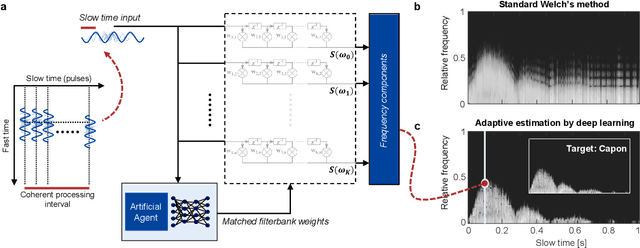

Abstract:We consider deep learning strategies in ultrasound systems, from the front-end to advanced applications. Our goal is to provide the reader with a broad understanding of the possible impact of deep learning methodologies on many aspects of ultrasound imaging. In particular, we discuss methods that lie at the interface of signal acquisition and machine learning, exploiting both data structure (e.g. sparsity in some domain) and data dimensionality (big data) already at the raw radio-frequency channel stage. As some examples, we outline efficient and effective deep learning solutions for adaptive beamforming and adaptive spectral Doppler through artificial agents, learn compressive encodings for color Doppler, and provide a framework for structured signal recovery by learning fast approximations of iterative minimization problems, with applications to clutter suppression and super-resolution ultrasound. These emerging technologies may have considerable impact on ultrasound imaging, showing promise across key components in the receive processing chain.
The Projected GSURE for Automatic Parameter Tuning in Iterative Shrinkage Methods
Mar 21, 2010



Abstract:Linear inverse problems are very common in signal and image processing. Many algorithms that aim at solving such problems include unknown parameters that need tuning. In this work we focus on optimally selecting such parameters in iterative shrinkage methods for image deblurring and image zooming. Our work uses the projected Generalized Stein Unbiased Risk Estimator (GSURE) for determining the threshold value lambda and the iterations number K in these algorithms. The proposed parameter selection is shown to handle any degradation operator, including ill-posed and even rectangular ones. This is achieved by using GSURE on the projected expected error. We further propose an efficient greedy parameter setting scheme, that tunes the parameter while iterating without impairing the resulting deblurring performance. Finally, we provide extensive comparisons to conventional methods for parameter selection, showing the superiority of the use of the projected GSURE.
 Add to Chrome
Add to Chrome Add to Firefox
Add to Firefox Add to Edge
Add to Edge